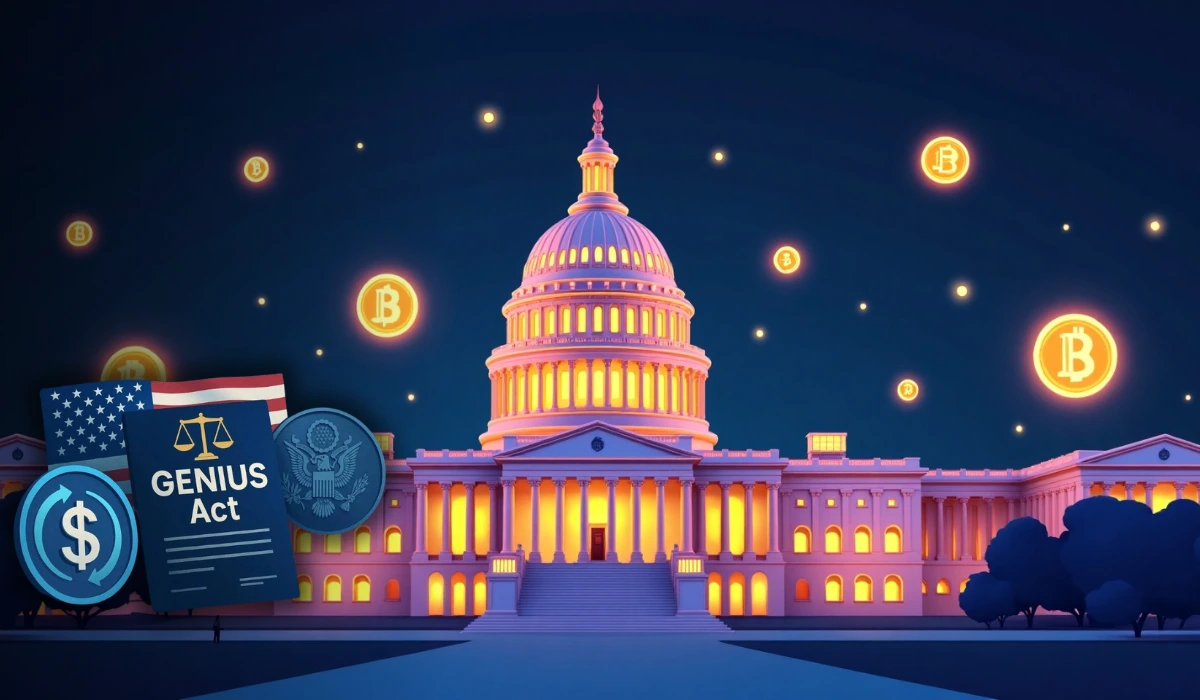In March 2025, the Senate Banking Committee passed a bipartisan bill to regulate US dollar-denominated stablecoins.
The Guiding and Establishing National Innovation for US Stablecoin Act, or GENIUS, is a landmark legislation that aims to implement a regulatory framework for payment stablecoins while integrating them into everyday financial transactions.
It represents the first federal regulatory environment for stablecoins in the United States, marking a significant step forward in clarifying regulatory expectations around digital assets and transforming the landscape of stablecoin across the world.
What Is The GENIUS Act?
The GENIUS Act was introduced in the US Senate on February 4, 2025, by Senators Bill Hagerty, Tim Scott, Cynthia Lummis, and Kristen Gillibrand.
The legislation aims to establish a regulatory framework for using stablecoins as payment instruments in the US. It was passed by the Senate Banking Committee on March 17, 2025, in a bipartisan vote.
The bill seeks to give US-based stablecoin issuers a competitive advantage over their overseas counterparts. The federal government views US dollar-pegged stablecoins as a tool to maintain international monetary dominance.
It distinguishes the fiat-pegged cryptocurrencies from speculative assets like Bitcoin and Ethereum, which can be highly volatile compared to fiat currencies.
The Senate Banking Committee approved the GENIUS Act after making amendments like imposing stricter rules for issuers, such as enhanced Anti-Money Laundering (AML) protections, reserve requirements, liquidity provisions, and sanctions compliance checks.
How Does the GENIUS Act Define Stablecoins?

Stablecoins are cryptocurrencies designed to maintain a stable and constant value by pegging their price to an external reference asset, typically fiat currencies or commodities such as gold.
Typically, they are fully backed on a 1:1 basis by US dollars or other approved high-quality liquid assets.
Stablecoins are crucial to addressing the volatility issues faced by crypto assets like Bitcoin and Ethereum by making them more practical for everyday transactions and financial services.
The GENIUS Act is focused on payment stablecoins and defines them as digital assets pegged to a fixed monetary value used primarily for payments and settlements.
The definition distinguishes the assets from other cryptocurrencies that are extremely volatile compared to fiat currencies.
Under the legislation, payment stablecoin issuers would be subject to the Bank Secrecy Act (BSA), similar to financial institutions, while limiting the issuance of the cryptocurrencies to approved entities.
Key Provisions of the GENIUS Act
If enacted, the GENIUS Act will be a milestone in the integration of digital currencies into the traditional financial system under a cohesive regulatory framework. Here are some key provisions of the bill:
1. Licensing and Regulatory Framework
The legislation establishes clear procedures for companies seeking licenses to issue stablecoins. It has introduced a dual regulatory regime that allows issuers to register their operations with a state or a federal regulatory authority.
The bill specifies that issuers with a market cap above $10 billion would be subject to federal regulation.
This dual approach provides companies with regulatory flexibility while maintaining rigorous oversight.
2. Reserve Requirements
The bill mandates that stablecoin issuers maintain a 1:1 reserve ratio by backing the crypto token with high-quality liquid assets such as cash, short-term US Treasury securities, or central bank deposits.
They must also separate operational funds from the reserve assets and undergo monthly audits and disclosures.
3. Transparency
Stablecoin issuers are required to disclose their reserve holdings and redemption policies to the public.
Furthermore, issuers must assign registered public accounting firms to conduct regular audits to verify compliance and solvency.
4. Anti-Money Laundering (AML) Compliance
Since the GENIUS Act classifies stablecoin issuers as financial institutions, they fall under the Bank Secrecy Act (BSA).
This obligates them to comply with AML laws, such as consumer identification, due diligence, and reporting of suspicious activities.
5. Consumer Protection
In the event of a stablecoin issuer becoming insolvent, holders are granted priority over other claims against the issuer. This provision would safeguard consumers and enhance the public’s trust in digital currencies.
6. Clarity on Regulatory Jurisdiction
The bill explicitly excludes stablecoins from being classified as securities, commodities, or investment companies under federal laws.
This clarification is crucial in delineating the regulatory boundaries and provides certainty for issuers and investors.
State and Federal Oversight on Payment Stablecoins Under the GENIUS Act
A key feature of the GENIUS Act is its dual regulatory oversight system, where issuers can obtain either a state or a federal license for operations.
Federal oversight applies to stablecoin issuers with a market capitalization exceeding $10 billion, thereby ensuring risk mitigation and compliance with broader financial policies.
Meanwhile, state-level regulatory bodies will oversee issuers with a market cap under the $10 billion threshold, given that the agencies follow federal-level guidelines.
Also Read: The Sandbox Long-Term Price Prediction: What to Expect in the Long Run?
Consumer Protection Measures Under the GENIUS Act
Here are the provisions for consumer protection promoted by the GENIUS Act for stablecoin issuers in the United States:
- Full asset backing is required for payment stablecoins to prevent de-pegging incidents, where their value deviates significantly from the asset, such as fiat currency or gold, that it is supposed to maintain parity with.
- It promotes clear redemption policies, allowing users to seamlessly convert their stablecoin holdings into fiat currencies.
- The bill requires issuers to undergo third-party audits regularly to enhance trust and market integrity.
How Are Stablecoins Currently Regulated In The US?
As of April 2025, stablecoin regulations in the United States remain a mixed bag, with no comprehensive federal or state-level framework overseeing their issuance and operation.
This lack of cohesion has led to overlapping jurisdictions and regulatory inconsistencies among federal and state authorities.
The Securities and Exchange Commission (SEC) and the Commodity Futures Trading Commission (CFTC), both federal agencies, assert authority over cryptocurrencies, including stablecoins.
The SEC has placed crypto assets in the same bracket as money market mutual funds, intending to regulate them as securities, while the CFTC views them as commodities.
In 2021, the CFTC imposed a fine of $41 million on stablecoin issuer Tether after finding that only 27% of its reserves were backed by US dollars, with most of its assets held in non-fiat financial instruments.
The regulator accused the company of violating the law by commingling operational and reserve funds.
Similarly, in June 2024, the US District Court for the District of Columbia ruled against the SEC in its lawsuit against Binance.
The court dismissed the regulator’s claim that the crypto firm’s official Binance USD (BUSD) stablecoin is a security.
Binance partnered with stablecoin issuer Paxos Trust to issue BUSD, which is regulated by the New York Department of Financial Services (NYDFS).
The court’s decision is important because it underlines that stablecoins backed 1:1 with fiat currencies do not inherently qualify as investment contracts under SEC jurisdiction.
One main challenge faced by the sector is dual oversight by different regulatory agencies without a unified approach, resulting in regulatory gaps.
The GENIUS Act aims to address this issue. The absence of a unified regulatory framework complicates compliance for token issuers, potentially exposing consumers to financial risks.
By bringing stablecoins and their issuers under the same regulatory standards as banks and other traditional financial institutions, systemic risks can be reduced.
Future Outlook of the GENIUS Act
If it becomes law, the GENIUS Act will not bring transformative changes to the stablecoin landscape in the United States, but globally by shaping regulation in markets actively looking to establish legal clarity for stablecoins.
Global regulators and industry stakeholders will be closely observing how the stablecoin law plays out once implemented.
If introduced effectively, then the GENIUS Act could accelerate market adoption, but any delay or inconsistency could lead to further uncertainty.
With the introduction of stablecoin-specific regulation, it will be interesting to see how issuers adapt their business model and asset portfolios to comply with new regulations.
However, there may be short-term challenges as the traditional financial markets adopt the asset class, but the long-term benefits of a transparent and secure market are expected to outweigh the hurdles.
Furthermore, the GENIUS Act could serve as a benchmark for other countries to work on their own stablecoin regulations.
Collaborative efforts from regulatory bodies across the world could help create a more integrated global financial system accommodating crypto tokens backed by stable assets.




